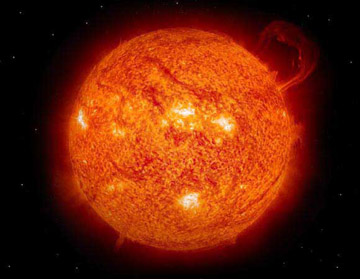What Can I Do?
Through most of this course we have discussed a range of predictions about the future effects of climate change, and taken a brief look at how we as a society can take steps to mitigate them. During your students’ lifetimes, it currently appears that the mean global temperature will increase by one to six degrees Celsius, causing widespread effects of increasing severity. It’s only natural for your students to wonder how they and their families can help mitigate future climate change.
Measuring Your Carbon Footprint
|
As you walk through a forest or along a beach, you leave behind footprints. In much the same way, every time you use an item or participate in an activity that produces greenhouse gases, you leave behind a carbon footprint. Your carbon footprint can be described as the total amount of carbon emissions that result from your lifestyle. It includes direct emissions, such as those from an automobile engine, as well as indirect emissions related to the products and services you use. A good way to begin understanding your carbon footprint is to use one of the many carbon footprint calculators available online. These simple tools allow you to calculate how much carbon is generated by each activity in your life and how your footprint compares to those of others. Many online footprint calculators compare your footprint to the footprint of people in other countries. It’s important to remember that not all calculators are the same! If you use more than one calculator, you will get different answers. |
EPA Personal Emissions Calculator
http://www.epa.gov/climatechange/emissions/ind_calculator.html
This calculator from the US Environmental Protection Agency is the basis of many other online calculators. It contains entries that are common to almost all footprint calculators, such as whether your home uses electric, natural gas, or oil for heating; miles driven in a year along with the estimated gas mileage; and information about waste disposal and recycling.
There are a couple of curious omissions from this popular tool. For example, there is no provision for more than one car per household (although you can combine the miles driven and average their fuel economy yourself), nor does it take into account airplane flights—a huge contributor to carbon emissions.
Carbon Footprint Calculator (The Nature Conservancy)
http://www.nature.org/initiatives/climatechange/calculator
The Nature Conservancy’s calculator is very good in that it takes into account not only how you heat your home, but also any steps that you may have already taken to increase efficiency. It allows you to enter more than one car as well as how many times you fly each year. A very interesting feature of the site is its inclusion of the impact of the food that you consume, since locally-produced food need not be transported very far. One obvious shortcoming is that although it does take into account the user’s state of residence, it cannot be used for non-US locales.
Zerofootprint Kids Calculator
http://zerofootprintkids.com
This calculator, produced by a Canadian organization, is very kid-friendly, and includes sections covering transportation, foods, home & school, and recycling. One particularly relevant section allows users to input information about TVs, computers, mobile phones, and other appliances. Although the transportation options are very simplistic, the food section includes information about fast food consumption and its contribution to one’s footprint. The same organization also provides a “One Minute Calculator” (http://earthhour.zerofootprint.net/), which allows you to input a few simple estimates to get a ballpark estimate of your footprint.
Comparing the Results
The table below summarizes the results from each calculator, based on a hypothetical 3-person household in Colorado. Each calculator was filled out on the basis of a 3-person family living in a 3-bedroom house with air conditioning and gas heat. The family owns one mid-size car that gets 25 mpg and drives it 15,000 miles each year. They make two trips by air each year for personal or business reasons. They eat fast food an average of once per week, and eat some organic foods. They take moderate steps to conserve energy and recycle their waste. In cases where the calculator provides individual footprints, the results were multiplied by 3 for comparison to those that provide a combined footprint.
Footprint Calculator |
Calculated Footprint |
Average US Footprint |
EPA |
24.1 tons CO2/year |
20.8 tons CO2/year |
Nature Conservancy |
71.0 tons CO2/year |
80.0 tons CO2/year |
Zerofootprint Kids Calculator |
36.6 tons CO2/year |
29.4 tons CO2/year |
Zerofootprint 1-minute Calculator |
44.9 tons CO2/year |
39.0 tons CO2/year |
As you can see, each calculator provided inconsistent values. This isn’t too surprising, since each calculator asked a different set of questions, but interpreting the results can be confusing. Each calculator provided comparisons to an “average” US footprint (listed above in the right column, but even those values varied wildly.
So what do the results mean? Is any calculator better than another? There really isn’t a concrete answer to these questions, since each one is built around a different set of assumptions and each organization has a different goal. Many of the online calculators are provided by organizations that solicit money to offset your carbon footprint by planting trees or purchasing various forms of “carbon credits.” Others are provided by energy companies, which might bring up the question of objectivity.
These calculators, although potentially useful, focus on the actions users are directly responsible for, such as heating, lighting, and personal transportation. They tend to ignore each user’s share of their community’s footprint. Almost every community has a basic infrastructure including gas, water, electricity, and communications, as well as services including public safety, transportation, and education. Each of these carries an indirect footprint that must be shared among the residents.
Taking Tiny Steps
By now, it should be clear that there is not a single easy answer to the problem of climate change. Some people, including your students, might feel that the problems facing us are insurmountable. Fortunately, there are many ways that individuals can conserve energy and reduce their carbon footprint. Some “tiny steps” from various web sites include:
- Turn off electronics and electrical appliances when not in use
- Turn down the heat 2 to 4 degrees
- Turn up the air-conditioning 2 or more degrees
- Turn down your water heating (2 degrees will make a significant saving)
- Completely fill your dishwasher and washing machine before running them
- Unplug your MP3 player, mobile phone, laptop, etc. as soon as it has finished charging
- Install energy-saving light bulbs as the current ones burn out
- Carpool to work or school
- Use public transportation whenever possible
- Don't buy bottled water if your tap water is safe to drink (especially if it has been shipped from far away)
- Buy local fruit and vegetables, or even try growing your own
- Don't buy fresh fruit and vegetables which are out-of-season
- Try to buy products made closer to home
- Buy organic produce
- Recycle as much as possible
- ...and many others!
Remember...
Never doubt that a small group of thoughtful, committed citizens can change the world. Indeed, it is the only thing that ever has.
–Margaret Mead
Few will have the greatness to bend history itself; but each of us can work to change a small portion of events, and in the total of all those acts will be written the history of this generation.
–Robert F. Kennedy
It is not the strongest of the species that survives, nor the most intelligent, but the one most responsive to change.
–Charles Darwin















